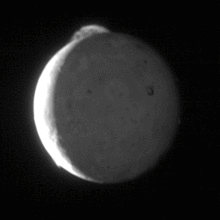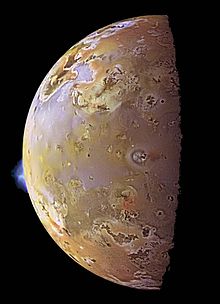Volcanism on Jupiter's moon Io

The volcanism on Jupiter's moon Io creates lava flows, volcanic calderas and ejections of sulfur and sulfur dioxide several hundred kilometers high . Volcanic activity was discovered in 1979 on images from the Voyager 1 spacecraft .
Io is believed to be the most volcanically active body in the solar system (other examples of volcanic activity are Earth , Saturn's moon Enceladus, and Neptune's moon Triton ). Observations of Io by space probes (Voyager, Galileo , Cassini-Huygens , New Horizons ) and by terrestrial telescopes have led to the discovery of more than 150 active volcanoes. There are believed to be up to 400 volcanoes in total.
description
As predicted just before Voyager 1's flyby, the source of Io volcanism is due to its tides . These are caused by Io's orbital eccentricity and generate heat. This distinguishes it from the earth , whose core is hot due to radioactivity . Io's eccentric orbit causes slight differences in the gravitational pull of Jupiter between the nearest and farthest points in its orbit, and therefore a varying bulge exists in it, subject to the tides. This deviation creates frictional heat inside the moon. Without this tidal heating, Io, similar in size and mass to the Earth's moon, would be geologically dead and littered with numerous impact craters .
Ios volcanism led to the creation of hundreds of volcanic centers and extensive lava formations , which make the moon the most volcanically active body in the solar system. Three different types of volcanic activity have been discovered, differentiating between the duration, intensity and amount of the lava emitted and whether a volcanic pit was formed with the eruption . Lava flows on Io, often thousands of kilometers long, consist primarily of basalt , as do those of shield volcanoes on Earth, such as Kilauea , Hawaii . While most of the lava on Io is basalt, sulfur and sulfur dioxide have also been seen. In addition, eruption temperatures of 1600 K (1300 ° C) were measured, which can be explained by the eruption of ultramafic minerals . As a result of the existence of large quantities of sulphurous material in Io's crust and on its surface, some eruptions shoot sulfur, sulphurous gas and pyroclast up to 500 km into space , creating huge, umbrella-shaped plumes of smoke. This material colors the surrounding terrain red, white, and black, and provides Io's patchy atmosphere and Jupiter's complex magnetosphere matter. Spacecraft that have flown by Io since 1979 have observed numerous changes in their external shape due to their volcanism.
Heat source
The primary source of Io's internal heat is the tidal forces of Jupiter, which permeate the planet. This exogenous origin distinguishes Io from Earth, the heat of which is due to the radioactivity and accretion inside. In the earth these activities produce mantle convection and thereby plate tectonics . Ios heating depends on the distance between the moon and Jupiter, its internal composition and its physical state. Your rail resonance with Europe and Ganymede reinforces this process.
The release of energy on Io cannot be explained solely by the heating at shallow depths below the surface, because the tidal forces are too low. Heat must also be generated in the deeper layers of Io. In addition, the centers of energy release are shifted 40 ° further east than expected. However, the known volcanoes only give off 60% of the total energy released by Io. It is therefore speculated that the missing 40% could be released from previously undiscovered, comparatively small volcanoes.
discovery

Before Voyager 1 met Io on March 5, 1979, it was mistaken for a dead body, such as Earth's moon. The discovery of a sodium cloud surrounding Io led to the theory that it was surrounded by evaporites (rocks formed by evaporation).
The first traces came from observations made from Earth using infrared technology in the 1970s . An unusually hot flow of heat compared to the other Galilean moons was detected by infrared measurements at 10 µm while Io was in the shadow of Jupiter. At this time the heat flow of the surface was ascribed to Ios, which accordingly has a higher thermal inertia than Europa and Ganymede . These results differed significantly from measurements taken at a wavelength of 20 µm, which suggested that the surface features of Ios were identical to those of the other Galilean moons. It was later determined that the warmer current at short wavelengths is based on the fact that the heat flows from heating by the sun and those of the volcanoes Ios are mixed, while heating by the sun diffuses warmer currents at longer wavelengths. A sharp increase in thermal radiation Ios was reported on February 20, 1978 by the Witteborn et al. discovered. The group moved at this time volcanism into consideration, in which case the data to a region Ios of 8,000 km² at 300 ° C were. Still, the scientists considered this thesis unlikely and instead focused on the emission from Io's interaction with Jupiter's magnetosphere.
Shortly before Voyager 1's encounter with the satellite, Stan Peale, Patrick Cassen, and RT Reynolds published a paper in the journal Science in which they predicted a volcanic surface and a delineated interior with distinct rock types rather than a homogeneous mixture. They substantiated their prediction by taking into account the tremendous heat generated by the abrasive force of the tides. Their calculations showed that the intensity of an Io with a homogeneous interior is three times that of a radioactive nucleus. This effect is even greater with a heterogeneous interior.

Voyager 1 's first images revealed the absence of impact craters, suggesting a very young surface. Craters are used by geologists to estimate the age of a planet's surface; their number increases with the age of the surface. In contrast, Voyager 1 discovereda multi-colored surface, scarred by irregular furrows. Such furrows can usually be traced back to the edges of impact craters. Voyager 1 also observed flow characteristics, formed by low-viscosity , i.e. thin-bodied substances , and large, isolated mountains that do not resemble terrestrial volcanoes. The exploration of the surface indicated that, as Peale and his colleagues predicted, Io is heavily volcanic.
On March 8, 1979, shortly after Jupiter passed, Voyager 1 took photos of Jupiter's moons to help mission engineers pinpoint the exact position of the spacecraft , a process called optical navigation. Linda A. Morabito-Kelly discovered a 300 km cloud along the edge of the moon while taking a series of images of Io to improve the visibility of the stars behind it . At first she mistakenly suspected the cloud to be a moon behind Io, but no suitably sized body could be in this position. The finding was determined as a plume of smoke produced by a dark furrow , later named Pele . Following this discovery, seven other plumes of smoke were discovered on earlier Voyager images of Ios. Thermal emissions from multiple sources, evidence of cooling lava , were also found. Changes on the surface were discovered when images acquired from Voyager 2 were compared to the four months older from Voyager 1 , including new deposits of plumes of smoke at Surt and Aten Patera .
Web links
Individual evidence
- ↑ a b L. A. Morabito, et al. : Discovery of currently active extraterrestrial volcanism . In: Science . 204, 1979, p. 972. doi : 10.1126 / science.204.4396.972 .
- ↑ RMC Lopes, et al. : Lava lakes on Io: Observations of Io's volcanic activity from Galileo NIMS during the 2001 fly-bys . In: Icarus . 169, 2004, pp. 140-74. doi : 10.1016 / j.icarus.2003.11.013 .
- ↑ a b c d S. J. Peale, et al. : Melting of Io by Tidal Dissipation . In: Science . 203, 1979, pp. 892-94. doi : 10.1126 / science.203.4383.892 .
- ^ JM Watson: Some Unanswered Questions . United States Geological Survey . May 5, 1999. Retrieved October 11, 2008.
- ↑ L. Keszthelyi, et al. : New estimates for Io eruption temperatures: Implications for the interior . In: Icarus . 192, 2007, pp. 491-502. doi : 10.1016 / j.icarus.2007.07.008 .
- ^ DA Williams, Howell, RR: Active volcanism: Effusive eruptions . In: Lopes, RMC and Spencer, JR (eds.) (Eds.): Io after Galileo . Springer-Praxis, 2007, ISBN 3-540-34681-3 , pp. 133-61.
- ^ PE Geissler, MT McMillan: Galileo observations of volcanic plumes on Io . In: Icarus . 197, 2008, pp. 505-18. doi : 10.1016 / j.icarus.2008.05.005 .
- ↑ P. Geissler, et al. : Surface changes on Io during the Galileo mission . In: Icarus . 169, 2004, pp. 29-64. doi : 10.1016 / j.icarus.2003.09.024 .
- ↑ Priscilla Vega / Jia-Rui C. Cook: Mapping Volcanic Heat on Io , Jet Propulsion Laboratory, Date: June 8, 2012, Accessed: June 12, 2012
- ↑ Günther Glatzel & Gertrud Felber: Volcanoes on Jupiter's moon Io re-mapped , Raumfahrer.net, Date: June 10, 2012, Accessed: June 12, 2012
- ↑ FP Fanale, et al. : Io: A Surface Evaporite Deposit? . In: Science . 186, No. 4167, 1974, pp. 922-25. doi : 10.1126 / science.186.4167.922 . PMID 17730914 .
- ↑ a b J Morrison, Cruikshank, DP: Thermal Properties of the Galilean satellites . In: Icarus . 18, 1973, pp. 223-36. doi : 10.1016 / 0019-1035 (73) 90207-8 .
- ^ OL Hansen: Ten-micron eclipse observations of Io, Europa, and Ganymede . In: Icarus . 18, 1973, pp. 237-46. doi : 10.1016 / 0019-1035 (73) 90208-x .
- ^ DP Cruikshank, Nelson, RM: A history of the exploration of Io . In: Lopes, RMC and Spencer, JR (eds.) (Eds.): Io after Galileo . Springer-Praxis, 2007, ISBN 3-540-34681-3 , pp. 5-33.
- ^ FC Witteborn, et al. : Io: An Intense Brightening Near 5 Micrometers . In: Science . 203, 1979, pp. 643-46. doi : 10.1126 / science.203.4381.643 .
- ↑ BA Smith, et al. : The Jupiter system through the eyes of Voyager 1 . In: Science . 204, 1979, pp. 951-72. doi : 10.1126 / science.204.4396.951 .
- ↑ a b R. G. Strom, et al. : Volcanic eruption plumes on Io . In: Nature . 280, 1979, pp. 733-36. doi : 10.1038 / 280733a0 .
- ↑ R. Hanel, et al. : Infrared Observations of the Jovian System from Voyager 1 . In: Science . 204, No. 4396, 1979, pp. 972-76. doi : 10.1126 / science.204.4396.972-a .
- ↑ BA Smith, et al. : The Galilean Satellites and Jupiter: Voyager 2 Imaging Science Results . In: Science . 206, No. 4421, 1979, pp. 927-50. doi : 10.1126 / science.206.4421.927 .

